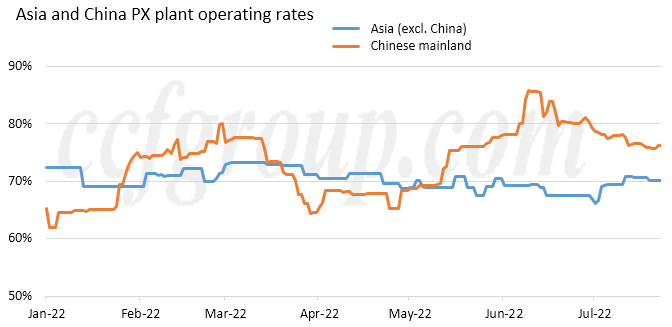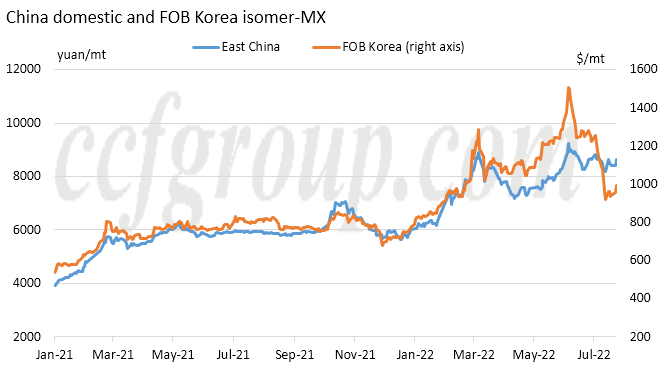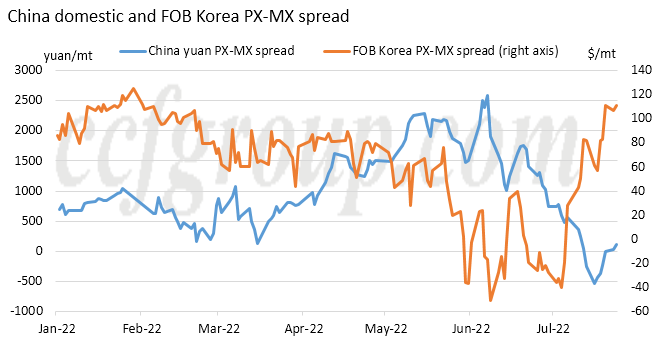PX plant operations affected by PX-MX spread
China PX plant average operating rate has been drifting lower since mid-Jun, down nearly 10 percentage points from the high point in mid-Jun as of Jul 22. Meanwhile, Asian PX plant operating rate outside China has been increasing slowly since Jul.

Besides from unexpected shutdown of PX plant in China and plant restart outside China, the operating rates change differently also because of divergence of China domestic MX and Asian MX prices.
As early as in end-Mar and beginning of Apr, the pandemic broke out in some regions of China, with government implementing lockdown and restrictions. As a result, China domestic consumption of refined oil products reduced sharply, leading to weaker demand for MX and continuous decline in the prices.
Meanwhile, outside China, due to the outbreak of Russia-Ukraine conflict, circulation of goods slowed down. US gasoline price spiked with increasing demand, driving up demand for blending components. With the widening of Asia to US arbitrage spread, Asian MX, toluene and PX prices soared in May. As of mid-Jun, FOB Korea MX price advanced a whopping 35% from May 1, while China domestic MX price gained 21%. The price spread of China domestic to FOB Korea MX kept widening in negative territory since H2 Mar, to minus 2600yuan/mt as of mid-Jun.

In the latter half of Jun, however, US gasoline price fell back, and Asia to US arbitrage narrowed. Asia MX price declined fast, while China domestic MX strengthened with demand for gasoline blending component recovering and PX plants increasing MX buying. China domestic to FOB Korea MX price spread widened in positive territory rapidly, to above 1000yuan/mt as of Jul 22, new high since the outbreak of pandemic.
It led to the difference in PX profits based on MX. Since late Mar, China PX-MX spread had widened from less than 150yuan/mt to 2600yuan/mt as of H1 Jun, up 1790%. With the attractive profits, China domestic PX plant operating rates hiked continuously. However, PX-MX spread on FOB Korea basis got squeezed from -$40/mt to -$150/mt over the same period, and thus the incentive to PX production based on MX theoretically weakened.
Since late Jun, however, MX prices have been moving divergently again. As China lifted restrictions, demand for refined oil products recovers. Demand for MX from PX production picks up and MX supply is tight. Therefore, domestic yuan MX price rises rapidly while PX-MX spread narrows. After CFR China PX is converted to yuan price, it was 500yuan/mt cheaper than MX as of mid-Jul, indicating losses in PX based on merchant MX in China. Some companies are mulling over selling MX instead of using it to produce PX.
On FOB Korea basis, PX-MX spread has rebounded since Jul with MX price pulling back. It has widened to $111/mt as of Jul 22. Though it was still slightly under break even line, the economics were bettered than PX based on yuan MX.

As China domestic yuan MX is much higher than USD price and exports from Asia to US reduce, China MX imports are expected to increase. Then, China yuan MX and PX spread may return to the normal range. However, it would take time for it to bolster PX plant operations. Firstly, the increase in MX imports may materialize as early as in mid-Aug or late Aug; and secondly, whether PX-MX price spread could recover needs further observations as Asian PX supply could also increase with Asia to US arbitrage window to shut.
In a conclusion, China PX plant operating rate decreased in Jul, due to the combination of plant issues as well as rising MX price. China domestic PX supply is expected to keep tight, and some downstream plants are under strains from low inventory of PX.
- Top keywords
- Cotton Price
- Cotton Futures Price
- Cotton Futures
- CZCE
- PTA Futures Price
- Chemical Fiber
- Polyester Prices
- Wool price
- PTA Futures
- Shengze Silk
- China
- Yarn Price
- price
- China Textile City
- Fibre Price
- Benzene Price
- Cotton
- Index
- Cotton Index
- PTA
- fabric price
- NYMEX
- Top 10
- textile industry
- Spot Cotton
- Cotton Yarn
- Polyester Price
- Futures
- PTA Price
- cotton yarn price

